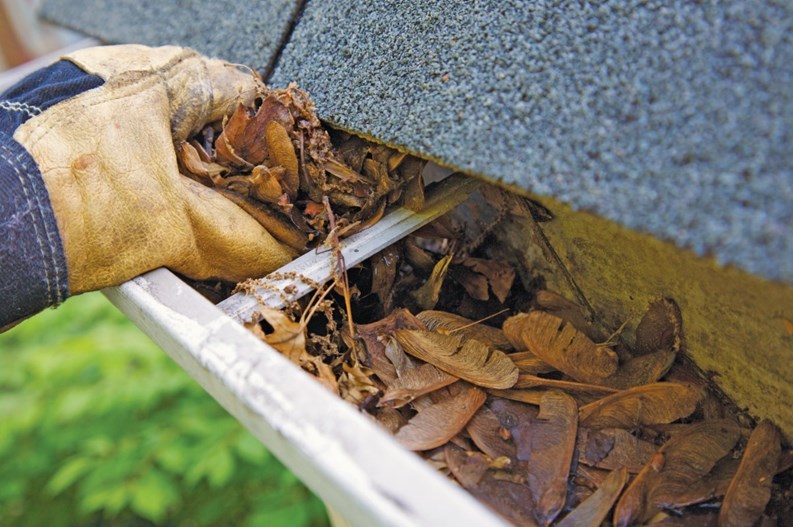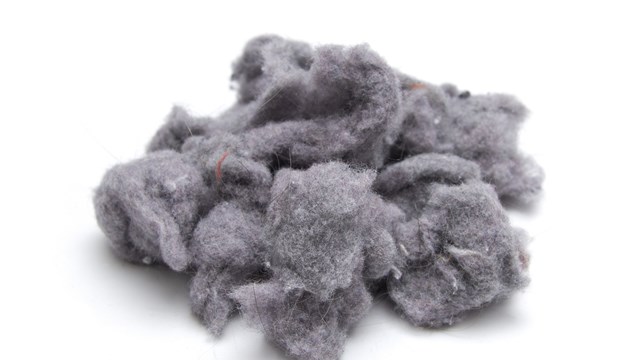Everyone knows the old phrase about April showers bringing May flowers, but what the saying doesn’t tell you is that the rain in April can also bring a lot of damage to your HOA's gutter system. Hard rain and blustery wind are always around once spring hits the air in New Jersey—and that weather can play havoc with the drainage requirements of any co-op or condo community.
Why They're Up There
“The gutters are there to create a channel for a directed flow of runoff from the roof,” says John Reddy, president of Continental Building Consultants, an engineering firm based in Hampton, New Hampshire. “Instead of cascading to the ground, water is directed into the gutters and downspouts, so as not to affect the building.”
Gutters are not only an important element of any rooftop; they are a necessity and should not be treated lightly. When a gutter overflows, it can leak into walls and cause expensive damage to plantings and paving. A clogged gutter with water spilling over can damage exterior paint, say the professionals, making it blister and peel much sooner than it ordinarily would. It can rot the fascia board, leak into your eaves, cause flooding in the basement and—perhaps worst of all—cracks in the foundation. If that seems like a lot of power, consider that it was water that created the Grand Canyon.
"You want to be able to control the flow of water, and if the gutter isn't functioning properly, you don't know where the water is going,” says Michael Pittaro of Garden State Gutter Cleaning in West Orange. “It could be going behind the gutter and into the building. It could be coming over the top. It could be going underneath the roof. If the water is not going in the place you want it to go, it could be rotting out the wood behind your siding. It could be destroying your foundation."
The pros point out that homeowners frequently don't spot a gutter problem until it's too late and damage has already been done. Even the best gutter and roofing professionals don't have x-ray vision, and it's very hard to see what’s going on behind a wall, or up in the attic. It’s often not until a unit owner sees a dark spot on the ceiling, or some rot on the eaves that they call in a professional, and by then the problem may have been going on for months or even years.
Don't Leaf it Alone
Problems arise quickly when downspouts are damaged, bent, or cracked or there is space between the flashings (the formed metal installed at roofing joints or intersections to prevent moisture from penetrating) and the roof. Winter is hard on all aspects of a building's exterior—and gutters are especially vulnerable, says Pittaro.
"If you have a lot of harsh weather, or a lot of ice sliding down the roof and no snow guards installed, all the sheets of ice are just hitting your gutters and banging the heck out of them." If properly maintained however, Pittaro says the life expectancy of a typical aluminum gutter is 20 to 25 years – essentially the life span of the roof itself.
"Salt in the air and water definitely plays a role in the life of a gutter,” says Mike Keller of George J. Keller & Sons LLC Flanders. "Structures near the ocean may experience different life spans and issues as compared to more inland scenarios."
According to the pros, if a gutter becomes clogged with leaves or other debris, any water left standing in the gutter will freeze when the weather turns cold. That ice will block more and more of the gutter, causing more water to pool and freeze, perpetuating the cycle of damage until the ice pushes right into joints at the eaves and can infiltrate into the building itself. Ice damming isn't the only consequence of lackluster gutter maintenance; leaf clogs can lead to other big problems, like mold and algae growth.
"Leaving leaves in gutters makes them unable to drain properly and causes water to run over the top of the gutter," says Evan Glaser of Gutter Master in Jackson. "That can cause rot over time if the problem isn’t taken care of."
Unfortunately, some people take the “out of sight, out of mind,” approach to gutters. As debris falls into the gutters, it’s hidden from the view of homeowners and association board members standing on the ground. But eventually, the problem will come to someone’s attention. “If your gutters are clogged up, you can see stuff sticking out of the gutters—and if it gets real bad, you can see things growing out of them,” says one contractor. “I’ve seen grass, and even little saplings growing out of gutters. When you see that, then you know you have a real problem.”
Staying on Top of Things
Generally, the professionals are in agreement that erring on the side of redundancy is the best policy when it comes to keeping up on your HOA’s gutter cleaning and maintenance program. A proper maintenance program is just as important for the top of your building as the bottom, and boards and associations need to keep this in mind. Most pros recommend that gutters be cleaned at least twice a year to avoid the problems mentioned above.
"Depending on your budget, you should do it in ate spring—May or June, once all the seedlings and pods and all that stuff have dropped," says Pittaro. "And again in late November or early December, once all the leaves have probably finished falling."
How often your HOA needs to attend to its gutters depends not just on budget but on the type of trees on your property, the contractors advise. Oak trees drop lots of acorns in the fall, and squirrels are notorious for knocking small branches into gutters. Pine trees drop needles all year round, and pine cones are almost custom-made gutter-blockers.
In order to assess the condition of a client's gutters, Pittaro says "We make sure the gutters are pitched properly—meaning they are angled properly, the water is getting into the downspout. We make sure all the end caps and miters—which are the corner pieces—are sealed. We also check that all gutters and downspouts are secured properly to the building, and that water is actually making it into the gutter."
When obstructions are found, different contractors take different approaches to gutter cleaning—from power washers to leaf blowers—but some prefer to do it the good old-fashioned way, getting up there and just scooping out the clumps with their hands and tools.
The one thing most gutter professionals agree on is the importance of knowing what you're doing and where you're stepping when working on a roof. The more foot traffic on a rooftop, the more potential for damage. So when in doubt, use a professional for your semi-annual gutter cleanings, especially in locations that are difficult to reach, or where buildings are set on challenging terrain.
Gutter Protectors
To avoid constant cleaning, especially in the tough locations, many condominiums have chosen to install various types of gutter protectors. Some are simply screens that act as colanders, filtering debris out of the water flowing through the gutter channel, whereas others work on different principles.
For example, Gutter Helmet has been on the market for more than two decades. The device is a solid aluminum cover with a 3/8-inch opening along the edge of the gutter. In use, water coming off the roof flows across the “helmet” and then flows back along its “nose” into the gutter. The only thing allowed into the gutter is the water, through surface tension.
Another product on the market is called Leaf Defier, and it essentially works by eliminating the empty space in the gutter that’s so prone to leaf blockage. The device is an open-cell polyurethane insert, specially shaped and cut to fit snugly into the gutter. The material, according to its manufacturer, is ultra-porous, so even during a downpour, rainwater flows through the Leaf Defier into the gutter valley and out the downspout. The spongy material is treated with a chemical biocide and fungicide to inhibit the growth of mold, mildew, fungus, and moss in the gutters.
Many homeowner associations aren’t going for one of these systems simply because they aren’t budgeted for such a large job to be done in one fell swoop. For those developments, a piece-by-piece approach may be more palatable—perhaps installing the devices at the backs of units where the trees are, or just in the wooded areas of the development.
Keep Trees Trim
In deciding how to deal with the maintenance, and whether to spend money for a gutter protection system, associations should consider their particular situation. If your condo is in a suburban area surrounded by trees close to the buildings, your gutter maintenance program will be more rigorous than an HOA centered in a wide open area. Whatever the situation, the pros agree that it’s always a good idea to keep your trees trimmed back and well away from gutters and eaves.
Former single-family homeowners may well be relieved that gutter cleaning is no longer their problem—but one resting on the shoulders of the association board and management.
That doesn't necessarily mean getting your super up a ladder to dig out leaf-clogs, however. "Putting ladders on gutters is not recommended," says Keller, "but can be done by a professional who understands placement and use of the ladder so as not to damage or dislodge the gutters." When associations are looking at a cleaning project, it’s important to go with a licensed company and since the maintenance work most likely isn’t going to cost an arm and a leg, the property manager should find someone with plenty of experience.
For those times when a full gutter replacement is necessary, prices generally reflect the square footage of the building or buildings, with some other factors playing a role as well. If a full roof replacement is in the cards, it may be cost-effective to replace the gutters as well.
"Simple gutter maintenance is a lot cheaper than spending thousands of dollars or even tens of thousands of dollars in fixing a major problem," says Pitarro, "but sometimes it's too late before you can even find out that you're having a problem." What it all comes down to is that with proper installation and a small investment in regular maintenance, your board/management team can get their heads out of the gutters and on to other important HOA business.
Keith Loria is a freelance writer and a frequent contributor to The New Jersey Cooperator. Editorial assistant David Chiu and Pat Gale, associate editor of New England Condominium, a Yale Robbins’ publication, contributed to this report.







Leave a Comment